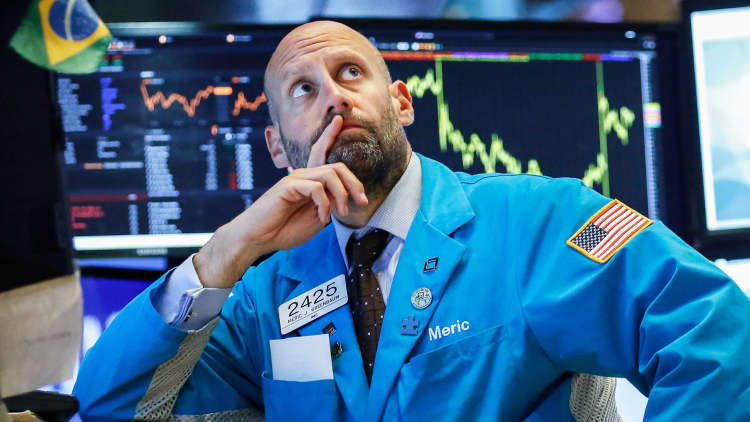
Global economic uncertainty has investors so fearful of the future, the world's cache of government bonds that trade at negative rates has ballooned to a new record high.
About $15 trillion of government bonds worldwide, or 25% of the market, now trade at negative yields, according to Deutsche Bank. This number has nearly tripled since October 2018.
As central banks around the world engage in unprecedented monetary easing, negative yielding debt is ballooning, endangering the way the global economy is supposed to function. The list of culprits for the phenomenon is long with investors blaming global central banks, the China-U.S. trade war, deflationary technology, a global shift in demographics and more.
The amount of global debt with negative yields continues to grow and as central banks scramble to react to a slowing economy they are seemingly making the yield decline worse. Overnight, central banks in India, New Zealand and Thailand surprised investors with interest rate cuts as all three nations joined the global shift toward easier monetary policy.
The Reserve Bank of New Zealand aggressively cut its benchmark rate by 50 basis points to 1%. The market was only expecting 25 basis points. "It's easily within the realms of possibility that we might have to use negative interest rates," the New Zealand Governor said.
In Germany, 30-year government bond went negative for the first time ever last week.
Other global central banks have been easing at unprecedented levels, with debt in Europe and Japan at zero or negative interest rates, while still producing weak economic data. Last month, European Central Bank President Mario Draghi signaled that the ECB will likely lower interest rates before the end of the year as "a significant degree of monetary stimulus continues to be necessary to ensure that financial conditions remain very favorable and support the euro area expansion."
Is this how bonds are supposed to work?
Historically, people give the government their money, instead of spending it, with the promise of being paid back, with interest. Now, governments are essentially getting paid to borrow money, as people become increasingly desperate for a safe haven for their wealth. The cycle becomes self fulfilling as negative rates raise further concerns about the economy.
"Bonds are supposed to pay the owner of capital something to pry the money out of their hands. But no … " said co-founder of DataTrek, Nicholas Colas.
Central banks often lower interest rates to grow the money supply in the economy, fuel demand and provide growth momentum. Other key drivers for monetary policy easing are weakening domestic outlooks, falling annual growth rates, low inflation and weakening business and consumer confidence. And in Europe's case, make up for the lack of a coordinated fiscal response.
Another reason for negative yielding debt worldwide could be that institutional investors, like pension funds, are forced to keep buying bonds because of liquidity requirements.
PIMCO's global economic advisor Joachin Fels said there are also secular factors like demographics and technology that drive rates lower.
"Rising life expectancy increases desired saving while new technologies are capital-saving and are becoming cheaper – and thus reduce ex ante demand for investment. The resulting savings glut tends to push the "natural" rate of interest lower and lower," said Fels.
U.S. not far behind?
Although the spread between U.S. bond yields and the rest of the world is wide, its possible the U.S. could get sucked into this global trend, according to Pimco, one of largest fixed income mangers in the world.
"U.S. Treasuries – which many investors view as the ultimate "safe haven" apart from gold – may be no exception to the negative yield phenomenon. And if trade tensions keep escalating, bond markets may move in that direction faster than many investors think," said Fels in a blog post.
Global central banks easing and uncertainty around the U.S.-China trade war is putting pressure on the U.S. Treasury 10-year yield. The yield on the benchmark 10-year Treasury note, was lower at 1.595% on Wednesday, the lowest level since October 2016 and 40 basis points lower than it was one month ago. The yield on the 30-year Treasury bond also dropped as low as 2.164%, near an all-time low hit in 2016.
The spread between the 3-month and 10-year notes is being watched as the spread is at its biggest inversion since April 2007, in the wake of the financial crisis.
The confluence of global economic uncertainty and the trade war spurred the Federal Reserve to cut interest rates for the first time since the 2008 financial crisis last week. After a 25 basis point reduction in the overnight lending rate, Fed Chairman Jerome Powell said "implications of global developments for the economic outlook as well as muted inflation pressures" contributed to the Fed's decision.
The odds of the Federal Reserve entering a deeper rate-cutting cycle are improving with a currency war between the U.S. and China that broke out this week. The Fed Funds watch tool estimates the Federal Reserve will lower interest rates three more times this year, with a 100% chance of a least one cut in September.
With the overnight lending rate between 2.25% and 2%, investors and economists debate whether more rate cuts will not leave the U.S. much room to act in the case of a recession.
Fels said the slowdown in the manufacturing sector has started to spill over into the labor market, as shown by Friday's July labor report. This combined with Trump's announcement of new tariffs on China are cyclical forces pulling U.S. rates lower and the Fed will have to react.
President Donald Trump has been outspoken about his call for Fed Chairman Jerome Powell to cut interest rates, saying the U.S. central bank needs to keep pace with its global counterparts.
On Wednesday, Trump tweeted, "They must Cut Rates bigger and faster, and stop their ridiculous quantitative tightening NOW."


